Deborah J. Ross's Blog, page 85
April 16, 2018
Crossroads of Darkover Author Interview: Pat MacEwen
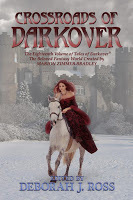 Coming in May, an all-new Darkover anthology featuring tales of decisions, turning points, love lost and found, all in the beloved world of the Bloody Sun. Stories by Jenna Rhodes, Pat MacEwen, Gabrielle Harbowy, Evey Brett, Rosemary and India Edghill, Diana L. Paxson, and more! Order yours today at: iBook, Kindle, Kobo, Nook. Table of Contents is here.
Coming in May, an all-new Darkover anthology featuring tales of decisions, turning points, love lost and found, all in the beloved world of the Bloody Sun. Stories by Jenna Rhodes, Pat MacEwen, Gabrielle Harbowy, Evey Brett, Rosemary and India Edghill, Diana L. Paxson, and more! Order yours today at: iBook, Kindle, Kobo, Nook. Table of Contents is here.Deborah J. Ross: Tell us about your introduction to Darkover. Pat MacEwen: My introduction to science fiction happened in the back of a station wagon on a cross-country road trip when I was 13. An older cousin took pity on me, and gave me a box full of paperbacks to help me pass the time. That’s where I met up with Asimov, Doc Smith, Poul Anderson, Heinlein and more. Once home again, I began to explore the genre, and was delighted to encounter female authors as well, and books with strong female characters and story lines.
DJR: What about the world drew you in? PE: Darkover was a rarity then – a complicated world with a long history where women mattered quite as much as men, and which often explored nonbinary questions of sex and gender and family and inheritance, and of course laran. Like most writers, I was something of a misfit in high school, but here was a place where I could see myself fitting in, one way or another. I’m also strongly attracted to moral questions in story-telling and tales of Darkover often focus on intricate problems concerning what’s right and wrong in this setting, compared to Terran mores.
DJR: What do you see as the future of Darkover? How has its readership changed over the decades? What book would you recommend for someone new to Darkover?
PE: When I look at the various maps of Darkover, I have to wonder how so many different species of sapient and semi-sapient species developed within what is really very limited space. Then I think about laran, and the ancient strengths of the chieri, and wonder if it was always that way. Whether it will stay that way. Between Terran geoengineering and long-lost arts in controlling laran, what if there are sunken continents or ice-covered regions that were once inhabited and might be rediscovered? What secrets might be hidden by water and ice? Where did the Catmen and the Ya-men really come from? Are the chieri all done with their genetic engineering projects? Are they quietly reshaping humans? Toward what ends? What about those four moons? Are they really moons? All of them? Are there more chieri elsewhere?
As for an introduction to Darkover, my personal favorites are The Shattered Chain and Thendara House, but there’s a lot to be said for Stormqueentoo, and Heritage of Hastur, The Alton Gift, and Sharra’s Exile.
DJR: What inspired your story in Crossroads of Darkover? How did you balance writing in someone else’s world and being true to your own creative imagination?
PR: I have a background in forensics and physical anthropology, having worked as a CSI for a California police department, and for the International Criminal Tribunal during war crimes investigations in the Balkans. I do independent research on genocide, and one of the aspects I’ve studied is the occurrence of certain crimes and atrocities during genocidal campaigns that are not expressly forbidden by law. They are acts almost never encountered in the course of “normal” warfare, no matter how savage. They are not committed by ordinary criminals, or even by serial killers. In many cases, they are so rare that no one keeps statistics on their occurrence, making research on the topic rather difficult. We don’t bother to even keep track of these acts because we don’t make laws against the things people simply don’t do. But on Darkover, thanks to laran and certain environmental cues, like the Ghost Wind, there are some kinds of assault and of murder that can be committed, and aren’t on the books. So how do you investigate them? How do you even prove they’ve been committed, let alone who did it? Even when you’ve made your case, how can you obtain justice?
As for writing in someone else’s universe, it’s a pleasure to explore “new” crooks and crannies in a setting I’ve enjoyed reading about. And because this whole complicated world has already been built, I can concentrate on the elements most useful to the story I’m telling. In any kind of speculative fiction, the most important factors are the limits – to magic, to science, to technology, to power, and to the characters’ own personal experience. When those limits have already been set by the world-building, I’m being handed a framework that makes it easy to focus on the story itself, and the character arcs taking place in it. And it’s a pleasure to honor the work that was done before I came along, as I add my own brick to the wall.
DJR: Is there another Darkover story you would particularly like to write?
PE: I think the characters in Wind Born are just getting started. The Terran forensic specialist really can’t go home again, and must make a place for herself on Darkover, like it or not. The Terran intelligence service isn’t likely to give up on the pursuit of laran and its secrets, which they see as possible weapons and sources of enormous power. There must be records hidden away somewhere of what the two agents described in the story have already learned and done, and very likely other covert programs are underway. What will the Comyn do about that, in self-defense and to keep the Terrans from generating a whole new and possibly interplanetary Age of Chaos? And what about the Renunciate, who may find that simply avenging her brother is not enough? Who may find herself drawn to the Terran in the same way as the Comyn Lord Darriel? Can either one help Gillian learn to control a laran-like “gift” that presents itself as an allergy, and has already come so close to killing her?
DJR: What have you written recently? What is your favorite of your published works and why?
PR: I’ve written and sold three new short stories this year, besides “Wind Born.” One, called “The Butcher’s Boy and the Piri Folk,” concerns the shortest man in British history and his encounter with the Little People. That one will be appearing in an anthology called Lace and Blade 4. The main character is also the subject of a screenplay in development and set some 25 years after events portrayed in The Three and The Four Musketeers, about which I can’t say much more at this point, although I’m pretty excited about it. Another story, “The Forever Boy,” is based on Cherokee lore and history. The boy in question is a survivor of the Trail of Tears who was taken in by the Cherokee version of the Little People when he escaped from the Blue Coats. Unable to face the memory of what happened to his original family, he rejects adulthood as well andis allowed to remain a boy for two hundred years – until history repeats itself and he has to choose a new path. That one has just come out in an anthology of stories about refugees of many kinds called Children of Another Sky, edited by Alma Alexander. A third story, “Mumia”, concerning the Black Death, grave robbers, apothecaries making medical treatments out of mummies, and the legendary founders of the city of Marseilles, will appear in a horror anthology called Mary Shelley’s Daughters.
My favorite piece of my own work, thus far, is probably the comic sf novelet “Home Sweet Bi’Ome” – it appeared in the Jan/Feb 2011 issue of F&SF, and was selected for Hartwell and Cramer’s Best Year’s SF anthology, vol. 17. That one’s about a woman with hyperallergic syndrome who lives in a house built out of her own DNA, and what happens to her and her love life when that house unexpectedly catches a very uncomfortable childhood disease. I’ve also published a novella, “The Lightness of the Movement,” in the March/April 2014 issue of F&SFwhich later made the Tiptree Honors List and was a finalist for the Sturgeon Award. That one is about a graduate student/ballet dancer and her misadventures when she encounters an alien species with an unusual kind of courtship display and no concept of motherhood. I like to play with ideas about alien sex, and societies based on non-human biology, so this was a lot of fun
DJR: What lies ahead for you?
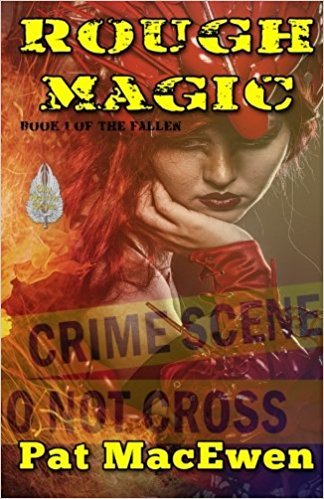 PE: I’m finishing up the second book in a forensic/urban fantasy series that began with Rough Magic and concerns refugee communities in a central California town that were stranded here by a catastrophe in Faerie. The main character is a former fairy queen now working as a CSI on criminal cases involving the denizens of Faerie and/or magic. The first volume is available here.
PE: I’m finishing up the second book in a forensic/urban fantasy series that began with Rough Magic and concerns refugee communities in a central California town that were stranded here by a catastrophe in Faerie. The main character is a former fairy queen now working as a CSI on criminal cases involving the denizens of Faerie and/or magic. The first volume is available here. A second book in a YA series that began with Dragon’s Kiss is also underway. This one concerns a crippled boy who can’t talk to humans but finds out he can talk to dragons, and must if either they or his own people are going to survive. The first volume is available here:
I’m also working on a steampunk novel (off and on, I admit) about Harry Houdini, who ran away from home at the age of twelve and was gone for a year. No one knows precisely where he went or what he did during that year, but he’d already put together his very own trapeze act at the age of nine, so I borrowed him and made him a crewman aboard a dirigible on its way to Europe, and a fateful encounter with sky pirates. The first third of that tale is called “A Proper Cuppa,” which appeared in the anthology Alterna-Teas in 2016, available here. Forthcoming segments will be set in the Catacombs of Paris, and in a clockwork version of Mad Ludwig’s Bavarian castle, Neuschwanstein.
DJR: Anything else you’d like our readers to know about you, Darkover, or life in general?PR: If you want to know what my non-fiction’s like, you can check out my blog, called BoneSpeak - where I have a lot to say about the Manson Family, from a forensic point of view, and the murders that happened after Charlie got locked up. Or there’s Fae Forensics - where I’m compiling
Pat MacEwen is a physical anthropologist. She works on bones from archaeological sites and does independent research on genocide. She worked on war crimes investigations for the International Criminal Tribunal, after doing CSI work for a decade, and was once a marine biologist at the Institute of Marine & Coastal Studies at USC. Rough Magic, first in a forensic/urban fantasy trilogy, The Fallen, is out from Sky Warrior Publishing. Dragon’s Kiss, a YA fantasy about a crippled boy who can talk to dragons, is also out from Sky Warrior. She writes mystery, horror, science fiction, and fantasy. Her work has appeared in a Year’s Best SF anthology. It has also been a finalist for the Sturgeon Award, and made the Tiptree Honors List.. Her hobbies include exploring cathedrals, alien-building via nonhuman biology, and trawling through history books for the juicy bits.

Published on April 16, 2018 01:00
April 13, 2018
Short Book Reviews: Another Novella Gem from Lois McMaster Bujold
Penric's Fox, by Lois McMaster Bujold (Subterranean Press)
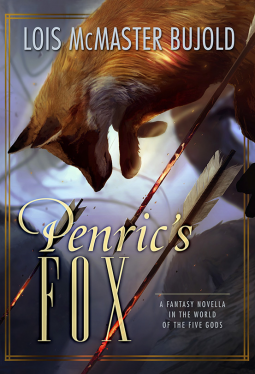
I’ve loved Lois McMaster Bujold’s World of the Five Gods ever since I picked up a copy of The Curse of Chalion. This novella follows the adventures of a sorcerer-scholar (Penric) and his resident chaos demon (Desdemona) as they encounter a murder mystery. In this world, chaos demons bestow various powers upon their hosts and carry the personalities of those hosts as they shift from one to the other when each host dies.
The mystery centers of the death of a sorceress and the absence of any trace of her demon, since no other human was nearby at the time of her passing. Where has the demon gone? Who killed the woman, and why? Where has the demon gone? (Yes, I know I asked that, but it's really, really important to not have a chaos demon either floating around or destroyed because it can't leap to a new host.)
Throw in a handful of utterly charming shamans, as well as other nicely depicted secondary characters, and the result is a delightful novella, just the right length to both savor the world and move the plot along nicely. When’s the next one coming out?
The usual disclaimer: This review arose from the gift of a complimentary review copy and nobody paid me to love the author's work because I already did. Are you happy, FCC?

Published on April 13, 2018 01:00
April 11, 2018
Today's Moment of Art
Published on April 11, 2018 01:00
April 10, 2018
Today's Wisdom from Middle Earth
“Living by faith includes the call to something greater than cowardly self-preservation.”
-- J.R.R. Tolkien, The Hobbit
-- J.R.R. Tolkien, The Hobbit

Published on April 10, 2018 01:00
April 9, 2018
Crossroads of Darkover Author Interviews: Jenna Rhodes

Coming in May, an all-new Darkover anthology featuring tales of decisions, turning points, love lost and found, all in the beloved world of the Bloody Sun. Stories by Jenna Rhodes, Pat MacEwen, Gabrielle Harbowy, Evey Brett, Rosemary and India Edghill, Diana L. Paxson, and more! Order yours today at: iBook, Kindle, Kobo, Nook. Table of Contents is here.
Deborah J. Ross: Tell us about your introduction to Darkover.
Jenna Rhodes: I met Marion Zimmer Bradley at a Westercon in northern California, while browsing the book dealer room. She indicated a selection of books and I looked them over, saying, “Oh, I don’t know her.” I did buy one or two paperbacks then and found out the next day I had been talking to the author.
DJR: What about the world drew you in?
JR: I always thought of Darkover as a challenging and intriguing world full of possibilities.
DJR: What inspired your story in Crossroads of Darkover?
JR: I’ve always been curious about the matrixes and how they live/function beyond the holder to which they’ve bonded. My story touches on that a little. How did you balance writing in someone else’s world and being true to your own creative imagination? If you are steeped in the books’ backstory, I think it’s easier to write stories that fill in the empty spots. Researching the canon is the challenge.
DJR: Is there another Darkover story you would particularly like to read?
JR: At the moment, I am looking forward to reading the latest book from Deborah Ross. She always incites my imagination, and I will probably have story ideas that bloom.
DJR: What have you written recently? What is your favorite of your published works and why?
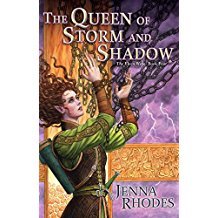 JR: The anthology stories I’ve had accepted these last few months: “The Locksmith’s Dilemma,” “Trust,” and “The Windlost” are all under my pen name Jenna Rhodes and I’m pleased with all of them. I’ve had more than 55 novels published, so it’s difficult to pick a favorite. I do love the four book series The Elven Ways I just finished for DAW. They please me because I like to stretch my writing and think I succeeded.
JR: The anthology stories I’ve had accepted these last few months: “The Locksmith’s Dilemma,” “Trust,” and “The Windlost” are all under my pen name Jenna Rhodes and I’m pleased with all of them. I’ve had more than 55 novels published, so it’s difficult to pick a favorite. I do love the four book series The Elven Ways I just finished for DAW. They please me because I like to stretch my writing and think I succeeded.DJR: What lies ahead for you?
JR: I’ll be re-writing The Late, Great Wizard, a novel for DAW soon, and have forged ahead in its sequel, The New, Improved Sorceress. The more I write, the more I think of to write.
DJR: Anything else you’d like our readers to know about you, Darkover, or life in general?
JR: I write under a number of different pen names: Jenna Rhodes, Elizabeth Forrest, Sara
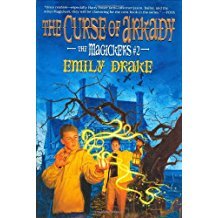 Hanover, Emily Drake as well as various of my name…Rhondi Vilott and R.A.V. Salsitz. No matter what name I choose, I’m always trying to create something challenging and interesting and magical for the reader.
Hanover, Emily Drake as well as various of my name…Rhondi Vilott and R.A.V. Salsitz. No matter what name I choose, I’m always trying to create something challenging and interesting and magical for the reader.Jenna Rhodes is one of the pen names of Rhondi A. Vilott Salsitz, known for her breadth of talent in science fiction, fantasy, and mystery. (She’s so prolific, she also writes as Emily Drake, Anne Knight, Elizabeth Forrest, Charles Ingrid, Rhondi Vilott Salsitz, R.A.V. Salsitz, Rhondi Vilott, and Rhondi Greening.) She’s been writing since she was in third grade and has published over 50 books and short stories.

Published on April 09, 2018 01:00
April 6, 2018
Short Book Reviews: A New Take on Dorian Gray
Creatures of Will and Temper, by Molly Tanzer, (Houghton Mifflin Harcourt), 2017.
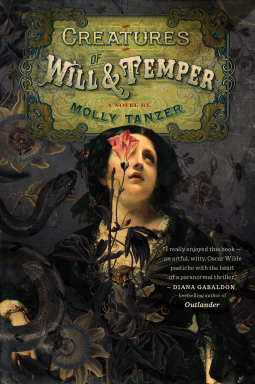
Part Victorian Gothic, part sword-swashing adventure, part witchcraft and part romance, this is a thoroughly delightful tale. With a nod here and there to Oscar Wilde’s The Picture of Dorian Gray, the story concerns two sisters on a visit with their uncle in London. The older sister, Evadne Gray, loves fencing and the neighbor youth, but the latter has left her heart-broken by announcing his engagement to another. She’s in London as a diversion from her sorrow and also as chaperone for her vivacious, rebellious, artistic younger sister, Dorina Gray. Soon they’ve gone their own ways, Dorina to the salon of Lady Henrietta Wotton and Evadne to study at a fencing academy. But matters are not all they seem, for in this world of Victorian high society, demons bargain with their human hosts in pacts ranging from benign to bloody.
This was my introduction to the work of Molly Tanzer but it won’t be my last. Besides the supernatural and mysterious, the depiction of a world of privilege and heartache, the story delves with sensitivity and insight into human relationships, thus setting it apart.

Published on April 06, 2018 01:00
April 3, 2018
Today's Wisdom from Middle Earth
“All have their worth and each contributes to the worth of the others.”
-- J.R.R. Tolkien, The Silmarillion
-- J.R.R. Tolkien, The Silmarillion

Published on April 03, 2018 01:00
April 2, 2018
Crossroads of Darkover Author Interviews: Robin Rowland
 Coming in May, an all-new Darkover anthology featuring tales of decisions, turning points, love lost and found, all in the beloved world of the Bloody Sun. Stories by Jenna Rhodes, Pat MacEwen, Gabrielle Harbowy, Evey Brett, Rosemary and India Edghill, Diana L. Paxson, and more! Order yours today at: iBook, Kindle, Kobo, Nook. Table of Contents is here.
Coming in May, an all-new Darkover anthology featuring tales of decisions, turning points, love lost and found, all in the beloved world of the Bloody Sun. Stories by Jenna Rhodes, Pat MacEwen, Gabrielle Harbowy, Evey Brett, Rosemary and India Edghill, Diana L. Paxson, and more! Order yours today at: iBook, Kindle, Kobo, Nook. Table of Contents is here.Deborah J. Ross: What about the world of Darkover drew you in?
Robin Rowland: I live in the mountainous coast of British Columbia, where we often experience what I like to call “Darkover weather.” This year winter started early, in mid-November. It started with rain, which changed to freezing rain, to wet snow to snow. One day we had 24 hours of heavy snow, followed again by sleet and then rain, and then another 24 hours of heavy snow. One day, I dug out my driveway four times, the next, the sun came out and it was warm and there was a heavy snow melt underway. Now in mid-January, we have had a lot less snow than usual, but over this weekend we had freezing rain that left layers of ice everywhere.
Many years ago Marion Zimmer Bradley told me in the Darkover Suite at Westercon that she was first inspired by the snow in upstate New York and later, in California, by the Sierras. Every science fiction fan brings their own experience to their enjoyment of stories. I grew up in Kitimat and retired here. In a local First Nations (Native Canadian) language Kitimat means “people of the snow. The valley at the end of an 80 kilometre fjord has a unique micro climate. Four times we’ve had a record one day snowfall for all of Canada. The weather can change to warm to wet in a half hour. Winters can see snow up to the roof of a typical Kitimat 1950s two story ranch style house or sometimes so little snow I only use a half bag of snow melter. Summers can either be dreary, overcast and wet or warm to very hot with the occasional drought. So for me, that unique micro climate of the Kitimat valley is perhaps the closest thing on Terra to Darkover.
DJR: Tell us about your introduction to Darkover.
RR: My family moved to Toronto when I was fifteen. As my only income at the time was an allowance, I haunted a huge used book store in downtown Toronto called “Old Favourites” which had a large science fiction section. I bought Star of Danger, the boys were my own age and the description of Darkover made the planet sound like the home town I had just left. I kept buying Darkover books, first used and then when I got after school jobs, new releases from a variety store near my home which always stocked with a lot of science fiction in the late 1960s. What convinced me that I loved the planet was Darkover Landfall, which again, reminded me of Kitimat.
DJR: What do you see as the future of Darkover? How has its readership changed over the decades? What book would you recommend for someone new to Darkover?
RR: I'd always recommend Darkover Landfall as a starter for any one who wants to get into the series, it is a great introduction.
One factor that is emphasized in today's fiction overall, is that in a diverse society more readers have to see themselves in the stories.
Marion Bradley began writing Darkover in the late 60s, early 70s, at the time that the women's and gay movements were just beginning. That was one of the factors that attracted the younger readers of the time, who saw themselves or what they fantasized they'd like to be by immersing themselves on Darkover. (There were about a dozen young gay men in the Darkover Suite in San Francisco at Westercon 79).
I suspect that although Darkover is still attracting some younger readers, it is likely that the core audience is loyal but aging.
So the future should be to find new ways of attracting a wide, diverse, millennial reader for whom science fiction is mostly just Star Wars and Star Trek and fantasy are a series of Lord of the Rings clones. When I talk to many younger science fiction fans in the LGBT community, many have never heard of Darkover, so I encourage them to go to Amazon if they can't find the books in the (shrinking number of) local stores.
I would encourage the Trust to reach out to published millennial science fiction or fantasy writers, even if they are not current Darkover fans, to be published in a special anthology, to bring new blood and a new perspective. They should include not just those of Celtic or Spanish heritage (always a strong part of the audience) but a wide diverse group of millennial writers from all cultural backgrounds, including indigenous writers, who can bring Darkover into the 21st century . (A number of indigenous writers in both the US and Canada are producing some amazing fantasy and magic realism these days. Afrofuturist stories are increasingly popular. The first anthology of Iraqi science fiction and fantasy in English was published in the UK in 2017).
Back in 1972, in Darkover Landfall, Marion Bradley said the crashed ship was originally destined for a mining colony. As one who lives in a region where there are many extractive industries, it is clear in the 21st century that those industries these days are extremely diverse with employees from all over the world (especially if they have specific engineering or technical expertise). Although she concentrated on the New Hebrides commune, she also said the passengers worked for companies that would be operated on the Coronis Colony.
That would open opportunities for millennial writers who can repeat Darkover's earlier success by, while staying as true as possible to the Darkover canon, give the younger audience a way of seeing themselves living on Darkover in the various ages of its history just as we did back in the 70s.
DJR: What inspired your story in Crossroads of Darkover? How did you balance writing in someone else’s world and being true to your own creative imagination?
RR: In 1976, after I read The Shattered Chain and the story of how Magda Lorne took an oath under duress, I wrote a fan letter to Marion Bradley about how my father, as prisoner of war of the Japanese in the Second World War, was forced to take an oath under duress not to escape. Deborah found the letter in the files and asked for a story based on that idea. The story went through at least a dozen different drafts, and the initial problem (in retrospect) was that the balance was trying to make a “based on a true story” approach into the creative world of Darkover. The endings were always a problem until Deborah suggested a new approach that took the story further away from the true story and more into the world of Darkover.
DJR: Is there another Darkover story you would particularly like to write?
RR: The Darkover stories are often about winter snows or summer forest fires. If you live in a mountain valley like I do, with heavy snow in the winter and perhaps forest fires in the summer, there’s a third story creating hazard that in all my years of reading about Darkover, that has never been tackled. Flooding. In a normal year, rivers rise twice with what are called “freshettes” when the snow melt flows into the river. The first freshette comes in the valleys (usually in March here) as the snow melts, but the second freshette happens in May as the snow melts at the higher elevations, and the water accumulates from hundreds of small streams into the creeks and then the rivers. In years that aren’t “normal” with heavier snow or rain, of if forest fires have created the right conditions, then there are floods, sometimes heavy floods. Very heavy rain at any time can cause flash flooding in the valleys as all the water quickly races down the mountains.
The terrible mud floods recently in southern California show just how devastating a post-fire flood can be, destroying everything in its path.
How would be people of Darkover (with or without laran) deal with floods? That could create stories in any era of Darkover history.
DJR: What have you written recently? What is your favorite of your published works and why?
RR: Most of my writing has been non-fiction.
My favourite was published a couple of magazine articles when I was just staring out in the 1970s, about the Canadian journalist Kathleen Blake “Kit” Coleman, who was the first woman ever officially accredited by the United States government as a war correspondent during the Spanish American War. Unfortunately, as I was following up and working up a book on her story (as a then unpublished book writer) an academic study of Coleman's career was published and that killed the market for a possible more popular account.
I am best known for co-writing the first computer manual on how to search the Internet (five years before Google started) Researching on the Internet , published in 1995.
I have written three non-fiction investigative histories. The first, and my second favourite work, was King of the Mob Rocco Perri and the Women Who Ran His Rackets, http://robinrowland.com/writing/books... story of Rocco Perri “the Al Capone of Canada” and his wife Bessie Perri. It was Bessie who really ran the gang, so she was the only woman and the only Jewish woman in history to run an Italian Mafia outfit. The sequel was Undercover,Cases of the RCMP's Most Secret Operative , the story of Frank Zaneth, which retold the story of Canada's Prohibition booze and drug rackets from the cop's point of view. The third was A River Kwai Story The Sonkrai Tribunal, about the River Kwai “Railway of Death” and the post war war crimes trials.
DJR: What lies ahead for you?
RR: I am working (or juggling) three projects at the moment. One is a science fiction murder mystery set in northwestern British Columbia in the far future, which is in its early stages. I am working on investigative non-fiction account of the copyright wars from the creators' (as opposed to the lawyers') point of view which I hope to wrap up by the middle of 2018. I am beginning preliminary research on a family history after I f0und from genealogical research that the “family business” for many of my eighteenth century ancestors was for at least five generations from 1700 to 1800 were acting as privateers during the various age of fighting sail wars of the period.
DJR: Anything else you’d like our readers to know about you, Darkover, or life in general?
RR: I wanted a creative hobby that got me away from writing so when I have the time I scratch build space ships and science fiction scenes. You can find them at http://robinrowland.com/wns/
Robin Rowland lives in Kitimat, British Columbia, a town in a northern mountain valley, which he says has a microclimate that closely resembles Darkover. Before retiring to his old
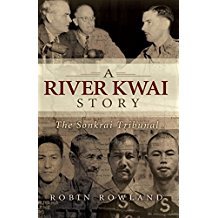 home town, he spent 30 years as a news producer and photographer for Canada's television networks. In 1995, he co-wrote Researching on the Internet, the first computer manual on how to search the internet. He is mostly a non-fiction author, specializing in historical investigation, including two books on Canada's Prohibition gangsters. During the Second World his father, who became a prisoner of war after the Japanese occupied Singapore, was forced along with the other prisoners to take an oath not to escape from the prison camp. That became known as the Seralang Barracks incident and a full account is found in Robin's book A River Kwai Story: The Sonkrai Tribunal, and the original idea behind this story.
home town, he spent 30 years as a news producer and photographer for Canada's television networks. In 1995, he co-wrote Researching on the Internet, the first computer manual on how to search the internet. He is mostly a non-fiction author, specializing in historical investigation, including two books on Canada's Prohibition gangsters. During the Second World his father, who became a prisoner of war after the Japanese occupied Singapore, was forced along with the other prisoners to take an oath not to escape from the prison camp. That became known as the Seralang Barracks incident and a full account is found in Robin's book A River Kwai Story: The Sonkrai Tribunal, and the original idea behind this story.
Published on April 02, 2018 01:00
March 30, 2018
Short Reviews: A New, Award-Worthy Novella from Juliette Wade
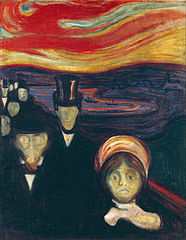 The Persistence of Blood, by Juliette Wade (Clarkesworld Magazine, Issue 138, March 2018)
The Persistence of Blood, by Juliette Wade (Clarkesworld Magazine, Issue 138, March 2018)Juliette Wade’s newest novella, set in her underground world of Varin, begins with what must surely squick out a certain percentage of male readers: a woman beginning her menstrual flow. But this is Varin, not Earth, and everything that looks familiar runs orthogonal to our expectations. The plight of Lady Selemei, who has now recovered sufficiently from her last, near-fatal childbirth to become pregnant again, must be understood in light of her technologically advanced yet highly stratified cavern-dwelling society. She is not a 21st Century Earth woman, and yet her situation must surely resonate with every woman who has thought for a heart-stopping moment that she might have an unplanned, unwanted pregnancy.
Selemei has few choices in the matter: forbidden to use or even possess information about contraception, and expected to churn out baby after baby for her caste in the hope that some of them might be healthy enough to survive, it seems her fate is sealed. If this description evokes of Margaret Atwood’s The Handmaid’s Tale, the resonances are deep rather than superficial. Selemei’s husband truly loves her, and the couple enjoys a rich and satisfying sexual relationship. She is not disposable in his eyes, or in her own. Celibacy to preserve her life is a an unappealing option. The two of them concoct a strategy to challenge the laws regarding contraception for their caste, within the limited circumstance of risk to the mother’s life. While insufficient in 21st Century terms, this represents a historic break with Varin tradition, certain to provoke fierce resistance. Whether in the chambers of the ruling council or a tea party for aristocratic ladies, or the simple fact that she cannot walk unaided, Selemei faces daunting obstacles.
The story’s strengths rely on the nuanced portrayal of the characters and the subtleties of their distinct, sometimes alien cultural context. In this sense, Selemei’s dilemma is not that of the Handmaids in Atwood’s tale or poor women throughout the world who lack affordable, effective birth control. It’s as much a love story as it is a political narrative. Never preachy, Wade invites the reader to draw conclusions not by diatribe but by following Selemei’s emotional journey. Courage comes in many different forms.
The painting is "Anxiety" by Edvard Munch.

Published on March 30, 2018 01:00
March 28, 2018
Today's Moment of Art
Published on March 28, 2018 01:00







